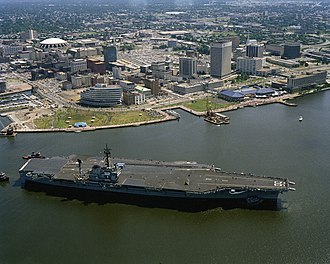
On May 14, 2005, a mighty giant of the seas met its end, not at the hands of enemy forces, but through a meticulously planned ordeal designed to shape the future of naval warfare.

The USS America, a decommissioned Kitty Hawk-class aircraft carrier, was intentionally sunk after a series of rigorous live-fire tests aimed at collecting valuable data for the design of future naval vessels.

This act of sacrifice, though controversial, highlighted the impressive durability of such carriers and underscored the challenges of sinking them—even intentionally.

The USS America, a conventionally powered super-carrier named by President John F. Kennedy and once hailed as “America’s flagship,” had a storied history.

Launched in 1965 and commissioned the same year, the carrier served with distinction in the Vietnam War, with engagements including Operation Desert Storm. After over three decades of service, the USS America was retired in 1996, sparking debates about her final fate.

Instead of transformation into a museum—a fate shared by other historic vessels—the Navy selected the USS America for a unique end: a live-fire testbed for future carrier survivability.

As the Navy released in a statement, “the data collected during the 25 days at sea from [the USS America’s] test events will be of great value to Navy engineers and designers to improve the design and survivability of the nation’s future aircraft carrier fleet.”

The Naval Sea Systems Command, responding to a Freedom of Information Act request, unveiled the location where the USS America was laid to rest: about 266 miles southeast of the Outer Banks.

The sinking was executed through controlled flooding and explosives set inside the ship, marking the culmination of a 25-day series of explosive tests.

These tests were instrumental for the design of the CVN-78, a carrier being planned at Northrop Grumman Newport News. Experts and engineers learned from the USS America that a double-hulled ship of its size was difficult to destroy, and that missiles would need to penetrate deeply through multiple compartments to critically damage such a vessel.

Thomas Trujillo, a member of the America Carrier Veterans Association, emphasized the carrier’s robustness: “It went down in one piece, by the bow.” Indeed, the America demonstrated exceptional resilience throughout the testing period. As one expert said, “It took four weeks and they ended up having to scuttle her from onboard due to her not sinking.”

The legacy of the USS America lives on, not just in the deep where she now rests, but in the lessons learned that have been integrated into the design of the new class of supercarriers like the Gerald R. Ford-class.

The dedication to improving carrier survivability and design ensures that the USS America’s story does not simply end with its sinking, but continues to influence the United States Navy’s pursuit of maritime superiority.

The USS America holds a record as the largest warship ever intentionally sunk—a distinction that underscores the massive scale of this undertaking.

Still, there’s a sense of honor in her final mission; as former Vice Chief of Naval Operations Adm. John Natham described, “America will make one final and vital contribution to our national defense, this time as a live-fire test and evaluation platform.”
Relevant articles:
– USS AMERICA’S SUNKEN LOCATION REVEALED, dailypress.com
– USS America: This Badass Aircraft Carrier Could Not Sink (The Navy Tried), The National Interest
– CV/CVA 66 History, ussamerica.org
– USS America: Why the Navy Failed to Sink Its Own Aircraft Carrier, The National Interest, Nov 26, 2023
